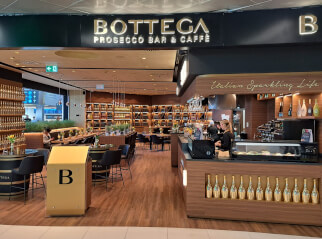Pearson Airport champions to be the best for future of travel
Five years ago, the Greater Toronto Airport Authority (GTAA) embarked on a journey to become the best airport in North America. Today, as Covid-19 continues to disrupt travel, GTAA has not wavered from its mission statement, ensuring it remains the best possible airport for the future of travel.
Americas Duty Free spoke to Giovanna Verilli, Director of Commercial Development at Toronto Pearson, to understand how the consecutive winner of “Best Large Airport in North Americas” is manoeuvring through this global pandemic as travelers and employees adjust to the new normal.
Verilli’s responsibilities at GTAA overlook the development of the retail, dining services, sponsorship, advertising and business. Her role not only develops and manages the business aspects, but establishes longer term growth and strategy in terms of what makes sense in terms of Toronto Pearson’s passenger base.
“As you know the travel and aviation industry has taken a major hit as a result of Covid-19 in the last several months and it’s no different here. We are quite hopeful. Our priority over the last few months has really been rebuilding confidence with the passenger and really focusing on building a healthy airport environment for our passengers and our employees. Also, making sure that we are ready to welcome them back to our facility and to return and interact with the airport through their travel journey. There is a lot of work to do. There is a lot of rebuilding to do. But we’ll do that together with our partners and our partners have been fantastic through this.”
Economic impact
With passenger numbers at Toronto Pearson at approximately 1996 operating levels, these changes reflect a significant decrease in global air traffic. In April 2020, the GTAA noted its passenger numbers were reduced by 97% compared to the same period of 2019.
“Our early estimate for the impact on Canada’s airports was a loss of between $1.8-2.3 billion. However, given the prolonged nature of this pandemic, those estimates now seem optimistic and we are engaged in revising forecasts and we expect them to be more dire than originally predicted,” explains Chris Phelan, Vice President, Government and Industry Affairs, Canadian Airports Council.
The workforce reductions follow numerous cost reduction measures the GTAA has implemented since the pandemic began, including a hiring freeze, reducing planned capital spending by $265M for 2020 and temporarily reducing executive and Board of Director salaries. Additionally, the company has leveraged the Canada Emergency Wage Subsidy and the Canada Emergency Commercial Rent Assistance programs and provided deferrals for eligible corporate partners.
Phelan explains the Canadian Airports Council has been calling on government to:
- Provide immediate financial support to Canada’s airports through a moratorium on ground lease rents and interest-free loans (or equivalent operational support) in order to cover operating costs and alleviate the need for rate increases during the recovery
- Expand national transportation infrastructure programs and support border modernization efforts to help Canada’s airports meet safety and security requirements and adapt to the new realities of COVID-19
- Increase the Airports Capital Assistance Program to $95 million per year to ensure sustainable recovery at Canada’s regional airports
- Provide sufficient funding for the Canadian Air Transport Security Authority (CATSA) to ensure it can meet its current and new mandates to protect the health and security of travellers and workers in the air sector
- Implement measures to stimulate domestic and international air travel to promote recovery in the Canadian tourism sector.
In terms of safety measures, Canadian airports are closely following the standards put forward by the International Civil Aviation Organization (ICAO) through their Council's Aviation Recovery Task Force (CART) report and the associated CART “Take Off” Guidance Material.
“Our current expectation is that passenger traffic in Canada will not return to 2019 levels until 2024. To offset that expectation as much as possible, the CAC is working closely with our government and industry partners in multitude of forums to rebuild confidence in air travel, eliminate/reduce the 14 day quarantine period, and explore Low Risk Travel Corridors,” says Phelan.
There has also been a nominal shift to understand how the demographic is shifting. There is a focus on what type of passenger is coming through Toronto Pearson and to understand what type of shopping and dining experience they are looking for.“The good news is that our partners have great operational plans, despite the volume of passengers. The plans they have put in place from a social distancing perspective, a cleanliness perspective, and a safe interactionperspective have prepared them for the return of higher passenger volume,” says Verilli. “Having said that, to have an increase in the number of people coming through our facility, we need to make sure that we are able to maintain social distancing at the airport and not just in common use places, but also within the stores and the restaurants.
Verilli states it is crucial to be able to pivot and accommodate for the ever changing passenger and regularity restrictions. “That is the big body of work for us right now. I won’t call it a challenge but that is the opportunity ahead of us.”
Healthy Airport initiative
GTAA launched its Healthy Airport initiative, a comprehensive program that outlines the steps the airport and its partners are taking to prepare for the new realities of air travel and lead the aviation industry in advancing the future of healthy travel corridors. At the center of the program: a strategic partnership with BlueDot, a leader in advanced data analytics and technologies to predict and monitor infectious disease risks.
She concludes, “It’s all about making sure that we don’t lose sight of all that great work that was done before. Thinking about technology, innovation, the right brands and concepts is always going to be critical for us. At the end of the day it’s all about putting the passenger first in everything we do. Despite new challenges every day, we have one common goal and this is making sure this airport is the best possible airport for the future of travel.”










